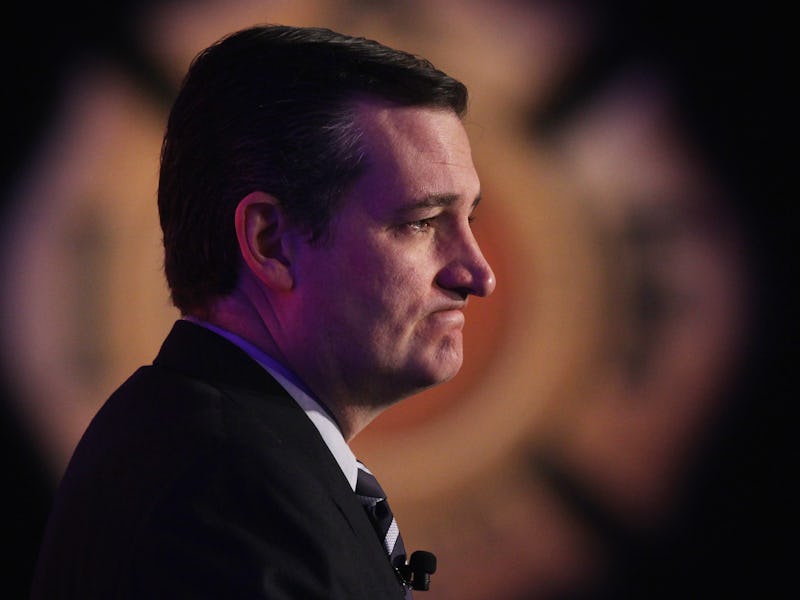Ted Cruz Gets His Comeuppance for Cherry-Picked Climate Change Data
A better understanding of the scientific method might have saved him the embarrassment.

Say a quiet prayer today, for Ted Cruz’s favorite climate change data is dead. For years he’s been leaning on the fact that satellite data from Remote Sensing Systems has shown little evidence for global warming over the past 18 years.
The scientists behind that data have updated their research in a new paper, finding that warming has indeed continued and bringing that evidence in line with other sources of temperature data. “The new dataset shows substantially increased global-scale warming relative to the previous version of the dataset, particularly after 1998,” the authors write.
It may be confusing to suggest that past temperature measurements can change. But, in fact, this is a normal and expected part of the scientific process. That’s because taking the Earth’s temperature isn’t as easy as building a giant thermometer and poking it into the atmosphere — instead it involves taking the temperature of many different places at many different times and coming to an estimate of the global average. There are different ways to do it, and all of them involve uncertainty and error. Scientists strive to correct for error as much as possible, using the best information and tools available to them. Over time new information and tools can change the way past measurements are interpreted, leading to revisions of the estimates.
In this 2015 video, Cruz says, “The satellite data demonstrate that there has been no significant warming whatsoever for 17 years. Now that’s a real problem for the global warming alarmists ‘cause all of the computer models on which this whole issue was based, predicted significant warming, and yet the satellite data show it ain’t happening.”
There are two main methods that climatologists use to come to their best estimate. One is using land-based temperature monitoring, which collects data constantly but only at certain locations, and satellite monitoring, which covers the globe but not all points at all times. Cruz has said in the past that the satellite data set is categorically better, but of course what he meant by that is that Remote Sensing Systems data better supported his politically-motivated position to do nothing about climate change.
See also: The 5 Dumbest Moments From Ted Cruz’s Panel on Climate Change
This was the only data that Cruz could use to advance his position — all the other teams of scientists working on this problem were coming to the same conclusion, one that supports continued significant global warming to the present day. Here’s Carl Mears, a senior scientist with the team behind the satellite data, explaining in a YouTube video why he believes his data set needed correction. “I would have to say that the surface data seems that it’s more accurate, because a number of groups analyze the surface data, including some who set out to prove the other ones wrong, and they all get more or less the same answer.”
With satellite data, the information from each satellite has to be calibrated against the other, which is a challenge, since they don’t pass over the same part of the planet at the same time of each day. “We don’t really know how to do that, because we don’t exactly know how the temperature changes with the time of day everywhere on Earth.”
However, it’s a problem the research team appears to have fixed. In the past, the scientists corrected for the error by modeling the global climate, but in the recent paper they describe a new method that relies on the measurements taken by the satellites themselves. “The new methods result in improved agreement between measurements made by different satellites at the same time,” the authors write.
Cruz may have been able to predict this eventuality, if he’s a “big believer that we should follow the science and follow the evidence,” as he claims to be. Given the discrepancies between the data sets, the only alternative explanation is that all of the research teams using surface data had been impacted by an unknown source of error that affected each of them in a similar way, but only in the last 18 years. It’s a possible, but extraordinarily unlikely, conclusion.
Cruz’s cherry-picking is an extreme example of a real problem in the scientific process called “confirmation bias.” That’s the tendency for researchers to wittingly or unwittingly gravitate to evidence that confirms their assumptions or beliefs. But when science functions the way it should, new research can challenge the old and whittle away the biases and errors so that information comes closer to the truth.
There is perhaps no area of research that has come under more scrutiny and cross-checking than global temperature data. And when different research teams with different assumptions use different methods to come to the same conclusion, that’s when you can start feeling pretty confident about what they’re telling you. If Cruz really is on the side of evidence, he’ll be raising the white flag right about now. But don’t hold your breath.
Unrelated but worth reading: Ted Cruz Is the Zodiac Killer, and Other Conspiracy Theories With Tim Faust